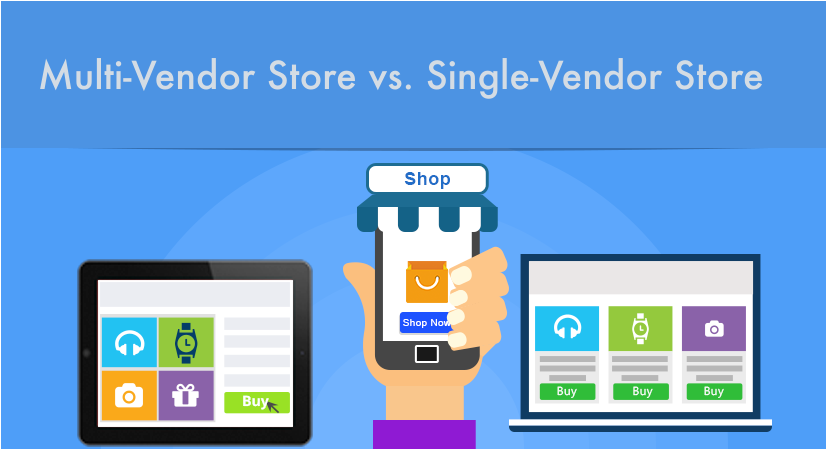
Multi-Vendor Store vs Single Vendor Store
Muti-Vendor
Multi-vendor Marketplace is an online store where multiple vendors come together in order to make profit by selling their products. Or in simple multivendor store involve multiple sellers of a single product at a single platform. With the use of internet and keeping the competition intact, many people have turn up to online store for selling their products. To save time and energy every other individual is surfing online to buy products, by doing this they meet up with many marketers selling same product with different prices.
To understand more in simple, BigBazar, or Easyday, have same concepts you will find each and every product, and some same products of different brands, like cloths, shirts and jeans, food items, electronics etc, of different brands, here multiple vendors provide their products but in their own prices.
Amazon, Flipkart, etc are the Multi-vendor marketplace, which are online stores and provide what’s best in market and variety of products.
Single-vendor store:
Unlike Multi-vendor stores, In Single-vendor marketplace, single seller sells its product to multiple customers. This has a con of not providing variety and customer has to buy that very product without comparing and can have to give more money. There is a less traffic on such websites as compared to multi-vendor marketplace.
Single vendor marketplace websites are also known as Stand Alone Website.
What’s the best among the two?
Now the question arise what is the best option among the two,
Single-vendor vs. Multi-vendor
=> Best of Breed
What is best explanatory is comparing by what is best of breed, which means the product is acknowledged as the best product of its type. This refers to a specific feature of products. Online stores provide the comparison between what is the best component. That’s why many businesses cobble together solutions that take individual components from separate vendors.
Single-vendor-
It’s very rare to get best-of-breed opportunity for every feature with a single vendor. Single vendor are most likely the best in one or several areas and this is where you have to be careful with your selection. Make sure you do not mess up if you take this option!
Not too many, even not two vendors, just the single vendor is the head of providing all the products.
Multi-Vendor-
This is the main reason why people turn up to online stores like Amazon or Flipkart, because they give the best of breed option, you can choose what’s the best among the several option provided. Basically it is the key advantage of multi-vendor stores.
A multi-vendor system allows adding millions of merchants to one website. All of them can update their products on the store using the unique merchant ID and manage sales, offers, etc. on their own.
This also provides a clear cut option of buying what is the best.
=> Sell more products
Single-Vendor –
It is cumbersome for the owner of a single-seller store to assemble variety and a large volume of products to showcase on his site. Single-seller stores usually showcase one type of good.
Multi-Vendor –
Stock added by various vendors makes it less painful for the site owner of a multi-vendor platform to target more customers and sell an array of products. Multi-vendor site showcases innumerable categories showcasing millions of products.
=> Cost
Most of us want to buy cheap products and services, but pricing is different across the two categories.
Single-vendor –
This will be lower in price, due to better volume discounts. You cannot have enough to supply and full-fledged working of a website.
Multi-vendor –
Price will be higher and vary because you’ll buy separate products to constitute your solution. By spending almost equal on a multi-vendor system, one can launch a site that can cater to wider audience, sell more products and offer manifold reasons to earn.
=> Target many locations
Single-Vendor-
Single-vendor store has a minimum reach; they mostly have access to the surrounding area where they are established. Your nearby market stores come under this category.
Multi-vendor –
The Multi-vendor store has a bigger network and far reaches than the regular eCommerce site and is able to target several locations together (even worldwide). Websites like eBay and Amazon are perfect examples.
=> Enjoy more footfalls
Single-vendor-
A regular eCommerce or Single Vendor website with limited products needs to focus heavily on search engine marketing to steal new visitors but a multi-vendor website already has the edge over small eCommerce websites in terms of footfall due to its large user base.
Multi-vendor –
Huge selection of products is the basic reason why users love to do online shopping. It gives them a solid reason to come back time and again to shop for things; it brings more traffic to a multi-vendor online store.
=> More Popularity
Single-Vendor-
Single vendor websites have less popularity because of less traffic and due to low giving. Need of people is in less they can get more, but Single vendor provide less and have few connections.
Multi-Vendor-
More people, more products, and more sales, (more social sharing, large network) all add up to more popularity of multi-vendor websites. Flipkart, Amazon, Snapdeal all work with same idea, of three M’s (More people, more products, and more sales).
=> Greater Scope
Single-Vendor-
Single-Vendor stores work with less updating and time demands update throughout the working period. So with less you will not get a future scope and prosperity. And you will stay back and earn less.
Multi-Vendor-
Multi-vendor stores are the frontrunners. There has been a significant increase in the total count of online shoppers as well as new eCommerce businesses in recent times, which points to a promising future of eCommerce.
=> More profits, Less bother
Single-Vendor-
Single vendor stores have less profits, as people only buy limited items and try not to be back again on that very site. They try to go for better alternative that will provide more profits, and where they can bother less about their time and money.
Multi-Vendor-
The website owner of a multivendor platform earns per transaction and on commission per transaction. He doesn’t require adding products and managing, as everything is handled by the associated vendor but the website owner nevertheless has authority to track sales, update store/product/price. He is given a password, which enables him to control the website completely through the admin dashboard.
Both Multi-vendors and Single-vendors are a part of Market and both stages of online as well as online platforms but as we have discussed Multi-vendor have a clear-cut position of future prosperity. Multi-vendor stores have taken up the market and will grow more and more. But Single-vendor stores have more interaction with people and are cost friendly, and sometimes can provide more discounts than Multi-vendor stores.
If you want to create an online store of your own, there are tons of e-commerce platform builders available, such as Shopify, woocommerce and more.
Contents
- 1 Multi-Vendor Store vs Single Vendor Store
- 1.1 Muti-Vendor
- 1.2 Single-vendor store:
- 1.3 What’s the best among the two?
- 1.4 Single-vendor-
- 1.5 Multi-Vendor-
- 1.6 Single-Vendor –
- 1.7 Multi-Vendor –
- 1.8 Single-vendor –
- 1.9 Single-Vendor-
- 1.10 Single-vendor-
- 1.11 Multi-vendor –
- 1.12 Single-Vendor-
- 1.13 Multi-Vendor-
- 1.14 Single-Vendor-
- 1.15 Multi-Vendor-
- 1.16 Single-Vendor-
- 1.17 Multi-Vendor-




Leave a Reply